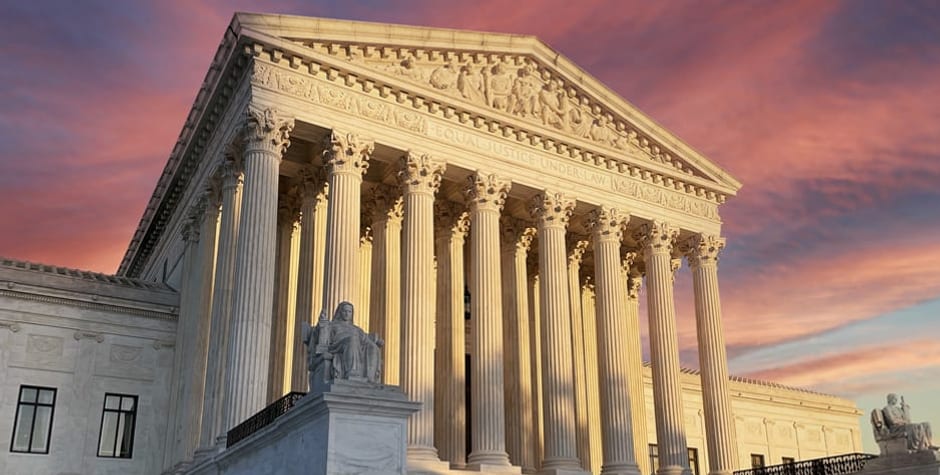Supreme Court Agrees With ACLJ Amicus Brief, Delivers Big Victory for Second Amendment
Today the Supreme Court issued its decision in the case of New York State Rifle & Pistol Ass’n., Inc. v. Bruen, a case being closely watched by both sides of our ongoing national debate over the Second Amendment’s protection of the right to keep and bear arms.
In a 6-3 opinion, the Court struck down a New York State law that required individuals who want to carry a “pistol or revolver” outside their homes to first satisfy a government licensing official that “proper cause exists” for doing so. But the “proper cause” requirement would be met only if an applicant could “demonstrate a special need for self-protection distinguishable from that of the general community.”
In other words, it wouldn’t be enough for the nurse, office cleaner, or second-shift garment worker to say she wanted to carry a pistol to defend herself against possible predators on the late-night subway platforms underneath Manhattan. That’s something anybody in the “general community” might be able to claim. She would have to show something more; some undefined “special need.”
As we previously reported, the ACLJ filed an amicus brief in this matter in support of the petitioners. In today’s decision, the Supreme Court held that the proper-cause requirement violates the Fourteenth Amendment by preventing law-abiding citizens with ordinary self-defense needs from exercising their Second Amendment right to keep and bear arms in public for self-defense. Applying its previous Second Amendment precedents of District of Columbia v. Heller, 554 U. S. 570, and McDonald v. Chicago, 561 U. S. 742, in which the Court held that the Second and Fourteenth Amendments protect an individual’s right to keep and bear arms for self-defense, today’s decision tracked our amicus brief’s argument that that right was not limited merely to a right to own arms in one’s home. As the Court’s opinion noted:
Nothing in the Second Amendment’s text draws a home/public distinction with respect to the right to keep and bear arms . . . The Second Amendment guarantees an “individual right to possess and carry weapons in case of confrontation,” and confrontation can surely take place outside the home.
The Court canvassed at length the relevant history of firearms regulation in English and American history, particularly with regard to the Founding Era, before concluding:
[W]e hold that when the Second Amendment’s plain text covers an individual’s conduct, the Constitution presumptively protects that conduct. To justify its regulation . . . the government must demonstrate that the regulation is consistent with this Nation’s historical tradition of firearm regulation. Only if a firearm regulation is consistent with this Nation’s historical tradition may a court conclude that the individual’s conduct falls outside the Second Amendment’s “unqualified command.”
As ACLJ Senior Counsel for Global Affairs, Mike Pompeo has explained:
Just as America cannot be a free nation without the ability to competently defend itself against its enemies, so too its people cannot be free if they have no rights enabling their own self-defense. That is why such a freedom was placed squarely in our Bill of Rights – second only to the freedoms of speech, religion, press, and assembly – thereby protecting it from government infringement – because the right to bear arms is essential to preserving our freedom as individuals.
At the ACLJ, we believe that the Second Amendment, the right to bear arms, and the right to self-defense are some of the most fundamental of constitutional rights – the guarantors of our other freedoms. From the Declaration of Independence to the Bill of Rights, the Founding Fathers made one thing abundantly clear: The government protects rights, it does not create them. This distinction is crucial because it defines what a legitimate government can and cannot do.
To best understand the danger of New York’s “proper cause” requirement for the exercise of Second Amendment rights, think of what would happen if the same sort of requirement were to be applied to First Amendment rights. Want to address your fellow citizens about an issue of public concern in a public park? Picket a business you think is doing something wrong? Hand out pamphlets supporting your favorite candidate? Imagine having to first prove to some government official that you have “proper cause” to do any of those things, “proper cause” to speak, to protest, to hand out literature; something more than just the same kind of desire that members of “the general community” always have to engage in the marketplace of ideas.
In the First Amendment context, the idea sounds preposterous, downright dangerous. Yet, in New York - until today at least - that same sort of process was required before otherwise law-abiding citizens could be allowed to exercise their Second Amendment rights.
Today’s decision, however, should put an end to such a distinction between the Second Amendment and other basic liberties enshrined in the Bill of Rights. In the Court’s words:
The constitutional right to bear arms in public for self-defense is not “a second-class right, subject to an entirely different body of rules than the other Bill of Rights guarantees.”
This Supreme Court ruling is indeed a victory for the Second Amendment and for your legal, constitutional right to purchase and carry a firearm. Especially now as just across the street, Congress is voting on new gun regulations we told you about through the Bipartisan Safe Communities Act. The Supreme Court has upheld your right to own a gun, and that could and should weigh heavily on any other gun legislation going forward.
